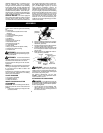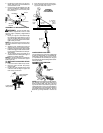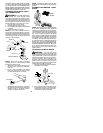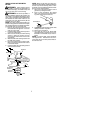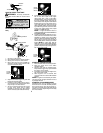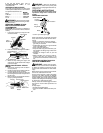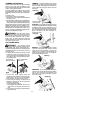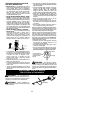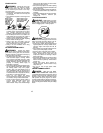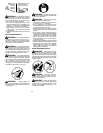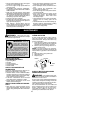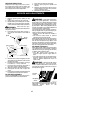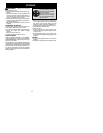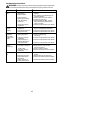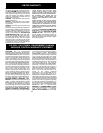
12
OPERATING INSTRUCTIONS FOR
USE WITH WEED BLADE
S
Blad e Thrust
is a reaction that only o ccurs
when using a bladed unit. This rea ction can
cause serious injury such as amputation.
Carefully study this section. Itis importantthat
you understand what causes blade thrust,
how yo u can reduce the chance of its
occurring, and how you can remain in control
of unit if blade thrust occurs.
S
WHA T CAUSES BLADE THRUST
--
Bla de
Thrus t
can occur when the spinning blade
contacts a n object that it doe s not cut. This
contact causes the bladeto stopfor aninstant
and then suddenly move or “thrust” away
from the object that was hit. The “thrusting”
reaction can be violent enough to cause the
operator to be propelled in any direction and
lose control o f th e unit. The uncontrolled unit
cancau seseriou s inju ry if the blade co ntac t s
the operator or others.
S
WHEN BLADE THRUST OCCURS
--
Blade Thrust
can occur without warning if
the blade snags, stalls, or b inds. This is
more likely to occur in areas where it is
difficult to see the material being cut. By
using the unit properly, the occurrence of
blade thrust will be reduced and the
operator will be less likely to lose control.
S
Cutonly grass,weeds,andw oodybrushup
to 1/2inch (1cm) in diameter withthe weed
blade. Do not let theblade contact material
it cannot cut such as stumps, rocks,
fences, metal, etc., or clusters of hard,
woody brush having a diameter greater
than 1/2 inch (1 cm).
S
Keep the blade sharp. A dull blade is more
likely to snag and thrust.
S
Cut only at full throttle. The blade will have
maximum cutting powerandis less likely to
bind or stall.
S
“Feed” the blade deliberately and not too
rapidly.Thebladecan thrustaway ifit is fed
too rapidly.
S
Cut only from your left to your right. Cu tting o n
rig ht side of the shie ld will throw d ebris a w ay
from the operator .
S
Use the shoulder strap and keep a firm grip
on the un it with both hands. A properly
adjusted shoulder strap will support the
weight of the unit, freeing your arms and
hands tocontrol and gu ide the cutting motion.
S
Keep feet comfortably spread apart and
braced for a possible sudden , rapid th rust of
unit. Do not overreach. Keep firm footing and
balance .
S
Keep blade below waist level; it will be
easier to maintain control of unit.
S
Do notraise t heengineaboveyourwaistas
the blade can come dangerously close to
your body.
S
Do not swing unit with such force that you
are in danger of losing your balance.
Bring the engin e to cutting sp eed before enter-
ing the mate rial to be cut.If the b lade d oes not
turnwhen yousqueeze thethrottle trigger, make
su r e sh af t is fully inser te d into t he en gine.
Always release the throttle trigger and allow
engine to return to idle speed when not cut-
ting. The blade should not turn while the en-
gineis runningatidle. I fthebladeturns atidle,
do notuse your unit. R e ferto theCARBURE-
T OR ADJUSTMENT section or contact your
authorized service dealer.
S
Maintain good firm footing while using the
unit. Do this by planting feet firmly in a
comfortable apart position.
S
Cut while swinging the upper part of your
body from left to right.
S
As you move fo rward to the next area to cut,
be sure to maintain your balance and footing.
Cut using the 2
o’clock to 4 o’clock
position of the
blade
2 o’clock
4 o’clock
RECOMMENDED CUTTING POSITION
W ARNING:
The operator or others
mustnottry toclear awaycutmaterial withthe
engine running or the blade turning to avoid
serious injury . Stop engine and blade before
removing materials wrappedaround bl adeor
shaft.
ADDITIONAL SAFETY RULES
FOR OPTIONAL ATTACHMENTS
W ARNING:
For each optional at-
tachment used, readentire instruction manu-
al before use and follow all warnings and in-
structions in manual and on attachment.
W ARNING:
Ensure handlebar re-
mains installed on upper s haft(engine endof
unit) at all times.
Handlebar



